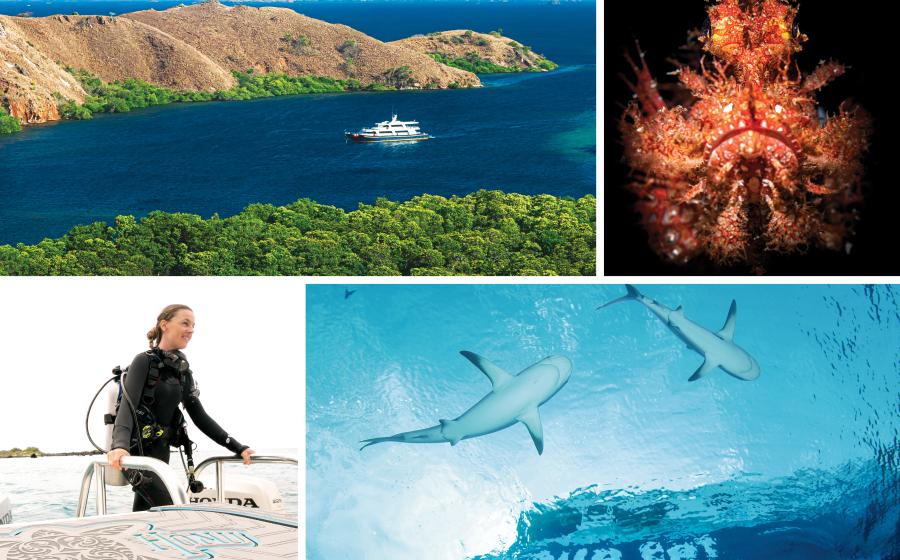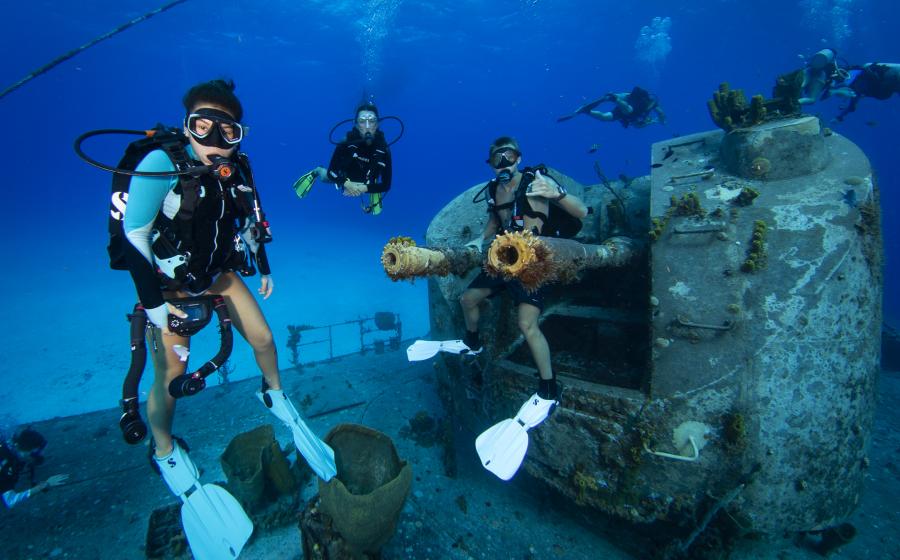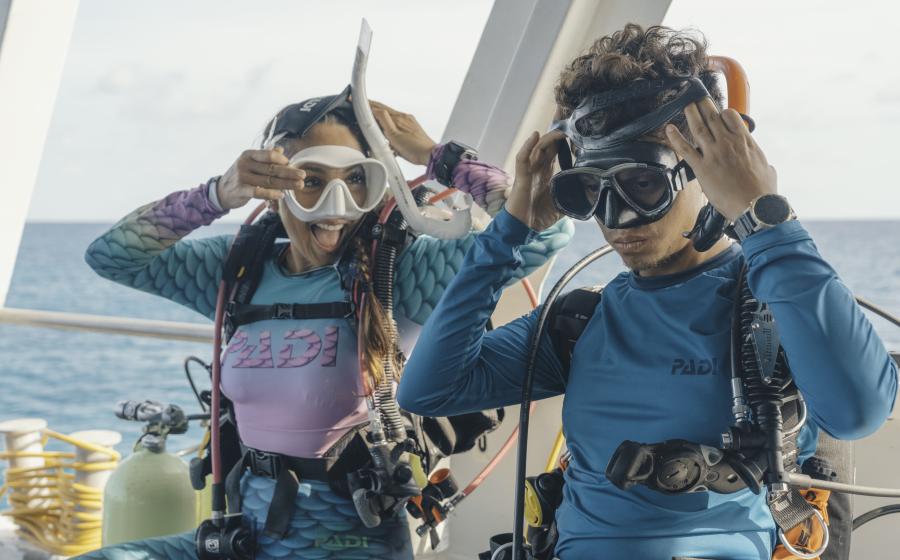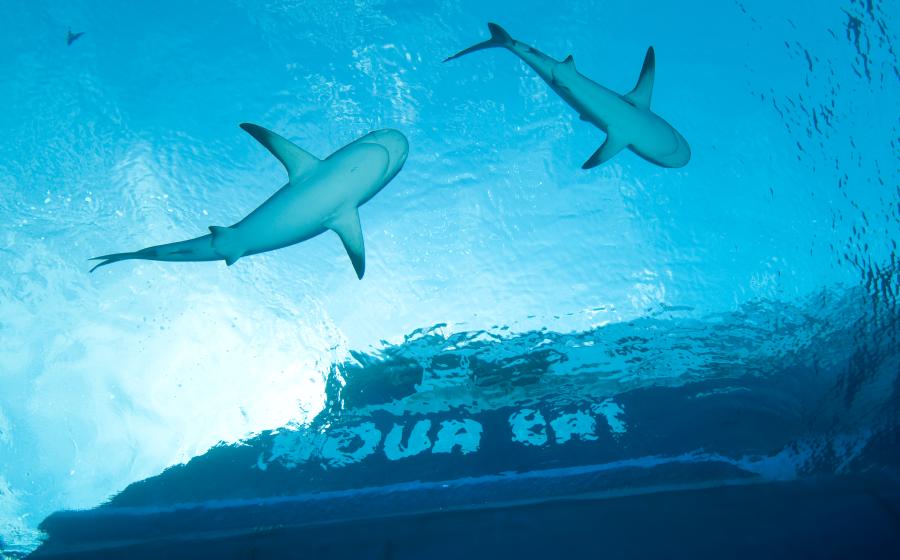Night Moves
 |
| When shooting wide-angle at night, having a subject that fills most of the frame helps eliminate backscatter. |
January 2004
Text and Photography by Stephen Frink
As any experienced night diver knows, the coral reef undergoes a dramatic change when the sun goes down. Creatures that are hidden during the day come out in droves. Tiny invertebrates and crustaceans you'd never see during the light of day roam the reef at night, while other creatures that are elusive during the day are somnambulant at night. Their rest time can be your photographic bonanza. Having trouble capturing a butterflyfish within your wire-framed close-up kit during the day? It's a slam-dunk at night. Tired of parrotfish bolting when you get within four feet of them during the day? Catch them tucked into their mucous cocoon at night.
You won't shoot big schools of fish--the grunts and snappers will be somewhere else for the evening--but you'll find turtles sleeping under ledges and lobsters and crabs tucked into hidey-holes across the reef. Abstract compositions of creatures like brittle stars and extreme close-ups of fish eyes can all be part of the evening's image capture. Even the backgrounds are different at night, when coral heads are fuzzy with polyps extended for feeding and the open water is black instead of blue.
The Gear
No matter what camera system you use, you'll need some form of underwater light. And, since your hands will likely be full of camera gear, fumbling around with a normal handheld dive light is a sloppy solution. Lights mounted to your mask might work well when using a Nikonos or other point-and-shoot system, but won't do you much good when you press your eye to the viewfinder of an SLR. Typically, you'll need some way for your camera system to illuminate the subject while your eye is trained to a viewfinder. There are three options for hands-free torch operation at night:
> Built-in model lights: Certain strobes, like the Ikelite 200/DS125 and Inon Z-220, have very powerful built-in modeling lights that provide sufficient illumination for night diving. Because the quartz bulbs are either within or adjacent to the strobe reflector, so long as the strobe is aimed at the subject (as it should be), you'll have plenty of light for composition and focus. The Inon actually takes it a step further by providing both a normal model light and a red laser spotting beam. As some creatures of the night are scared away by the bright light and heat from a quartz or halogen bulb, the laser provides a stealthy way to approach them. An integrated model light on a strobe can also serve as a focus-assist light when working under ledges or in low ambient light during the day. Note that not all model lights are equal in terms of adequacy as a stand-alone dive light. The now-discontinued Nikonos SB102 had what was called a "model light," but was actually a tiny, dull tungsten beam that did little except reduce battery life.
 |
| A tank-mounted light makes you visible to your buddy under water and the boat crew at the surface. |
||
|---|
|  |
|
| Make final camera adjustments in a well-lit area, or be prepared with your own light.|
> Strobe-mounted accessory lights: In a pinch, you can always duct-tape or rubber-band a small dive light to the strobe head, but there will be parallax. The strobe head will not be lighting exactly the same area illuminated by the dive light. At four feet away that might not matter, but at the close-focus distances possible at night, it can mean that the strobe won't light the subject as you intend. Some shooters prefer to slip a small wedge under the back end of the light to make the beams more coincident at normal shooting distances. In fact, some manufacturers of strobe holsters intentionally angle the light downward. But still, this is at times an awkward compromise.
> Shoe-mounted accessory lights: These are lights that mount directly to a housing or camera. Some housings, as well as Nikonos camera bodies, have an accessory shoe at the top, while others might have a 1/4" x 20 (standard tripod thread) or 8mm threaded hole at the top of the housing to accept after-market aiming light solutions. Light & Motion has built its SunRay Mod light specifically for this purpose, and offers a flexible arm and excellent beam angle and intensity for this application. Ultralight Control Systems has proved particularly adept at finding ways to attach dive lights to housings, and offers solutions that mount to macro ports, strobe arms and directly to housings or Nikonos cameras.
The Technique
Actually, night photography is very simple once you get your light aimed. Typically, you will be able to get close to your subjects so there will be excellent color and resolution, plus most of the subjects will be tucked in close to the reef, providing backgrounds that reflect enough light back to the sensor to ensure accurate TTL. However, you will need to approach subjects of the night reef in a slightly different way.
Many nocturnal fish will freeze when caught in the beam of a dive light, making it very easy to focus, shoot and bracket. But other night-feeding corals, invertebrates and anemones are quite light-sensitive and will bolt when caught in the beam of the light for more than a moment. For these subjects, a light of low intensity or even a red-filtered light is best. Alternatively, I find it sometimes helpful to prefocus on a nearby inanimate object like a piece of coral, shift to manual focus and then swing onto the subject for final composition, focus confirmation and shot. In this case, it's unlikely you'll get more than one shot, so make sure the strobe is aimed properly and the aperture is set for the correct strobe-to-subject distance before entering the "shoot zone."
||
|---|
|  |
|
| Shooting at night provides close access to subjects that might be reclusive during the day.|
Lenses optimized for macro and small-creature photography are usually the way to go for shooting after dark. Wide-angle is a problem in anything less than stunning visibility, as any bits of particulate matter show up as white spots against a black background. Most of my night images have been taken with either a 60mm or 105mm Micro-Nikkor in a housed camera or with the 50mm or 28mm lens on a Nikonos RS. The close-up kit and extension tube set for the Nikonos V are also well-suited to night photography. The wire framers that scare off creatures during the day tend not to bother most fish at night. Of course invertebrates could care less, day or night, but you're more likely to find them at night. Some of the reef life might be tucked into crevices that block access with a wire framer, giving the advantage to the housed SLR, but Nikonos shooters can slip the framers off and guesstimate composition when necessary.
Safety at Night
Your world at night is restricted to the beam of your dive light, so at the very least, make sure you have more than one. Too many times I've gone in the water with only the model light on my strobe as a dive light, but I know that if the battery dies or the strobe floods, I'd be out there without a light at all. Clip a spare light to your BC, no matter what you are using for a primary light. A small flashing beacon attached to the tank valve is another good idea in case your photographic pursuits take you too far from the boat and you surface beyond your ability to swim back.
Also be aware that some creatures found on the reef at night are hazardous. A number of species that are active after the sun sets are armed with pretty serious defense mechanisms. Sea urchin spines are a common hazard to night divers, and I have been stung by both lionfish and stingrays at night.
|| |---|
| |
| When shooting wide-angle at night, having a subject that fills most of the frame helps eliminate backscatter.|
|
| When shooting wide-angle at night, having a subject that fills most of the frame helps eliminate backscatter.|
January 2004
Text and Photography by Stephen Frink
As any experienced night diver knows, the coral reef undergoes a dramatic change when the sun goes down. Creatures that are hidden during the day come out in droves. Tiny invertebrates and crustaceans you'd never see during the light of day roam the reef at night, while other creatures that are elusive during the day are somnambulant at night. Their rest time can be your photographic bonanza. Having trouble capturing a butterflyfish within your wire-framed close-up kit during the day? It's a slam-dunk at night. Tired of parrotfish bolting when you get within four feet of them during the day? Catch them tucked into their mucous cocoon at night.
You won't shoot big schools of fish--the grunts and snappers will be somewhere else for the evening--but you'll find turtles sleeping under ledges and lobsters and crabs tucked into hidey-holes across the reef. Abstract compositions of creatures like brittle stars and extreme close-ups of fish eyes can all be part of the evening's image capture. Even the backgrounds are different at night, when coral heads are fuzzy with polyps extended for feeding and the open water is black instead of blue.
The Gear
No matter what camera system you use, you'll need some form of underwater light. And, since your hands will likely be full of camera gear, fumbling around with a normal handheld dive light is a sloppy solution. Lights mounted to your mask might work well when using a Nikonos or other point-and-shoot system, but won't do you much good when you press your eye to the viewfinder of an SLR. Typically, you'll need some way for your camera system to illuminate the subject while your eye is trained to a viewfinder. There are three options for hands-free torch operation at night:
> Built-in model lights: Certain strobes, like the Ikelite 200/DS125 and Inon Z-220, have very powerful built-in modeling lights that provide sufficient illumination for night diving. Because the quartz bulbs are either within or adjacent to the strobe reflector, so long as the strobe is aimed at the subject (as it should be), you'll have plenty of light for composition and focus. The Inon actually takes it a step further by providing both a normal model light and a red laser spotting beam. As some creatures of the night are scared away by the bright light and heat from a quartz or halogen bulb, the laser provides a stealthy way to approach them. An integrated model light on a strobe can also serve as a focus-assist light when working under ledges or in low ambient light during the day. Note that not all model lights are equal in terms of adequacy as a stand-alone dive light. The now-discontinued Nikonos SB102 had what was called a "model light," but was actually a tiny, dull tungsten beam that did little except reduce battery life.
|| |---|
| |
| A tank-mounted light makes you visible to your buddy under water and the boat crew at the surface.|
|
| A tank-mounted light makes you visible to your buddy under water and the boat crew at the surface.|
|| |---|
| |
| Make final camera adjustments in a well-lit area, or be prepared with your own light.|
> Strobe-mounted accessory lights: In a pinch, you can always duct-tape or rubber-band a small dive light to the strobe head, but there will be parallax. The strobe head will not be lighting exactly the same area illuminated by the dive light. At four feet away that might not matter, but at the close-focus distances possible at night, it can mean that the strobe won't light the subject as you intend. Some shooters prefer to slip a small wedge under the back end of the light to make the beams more coincident at normal shooting distances. In fact, some manufacturers of strobe holsters intentionally angle the light downward. But still, this is at times an awkward compromise.
|
| Make final camera adjustments in a well-lit area, or be prepared with your own light.|
> Strobe-mounted accessory lights: In a pinch, you can always duct-tape or rubber-band a small dive light to the strobe head, but there will be parallax. The strobe head will not be lighting exactly the same area illuminated by the dive light. At four feet away that might not matter, but at the close-focus distances possible at night, it can mean that the strobe won't light the subject as you intend. Some shooters prefer to slip a small wedge under the back end of the light to make the beams more coincident at normal shooting distances. In fact, some manufacturers of strobe holsters intentionally angle the light downward. But still, this is at times an awkward compromise.
> Shoe-mounted accessory lights: These are lights that mount directly to a housing or camera. Some housings, as well as Nikonos camera bodies, have an accessory shoe at the top, while others might have a 1/4" x 20 (standard tripod thread) or 8mm threaded hole at the top of the housing to accept after-market aiming light solutions. Light & Motion has built its SunRay Mod light specifically for this purpose, and offers a flexible arm and excellent beam angle and intensity for this application. Ultralight Control Systems has proved particularly adept at finding ways to attach dive lights to housings, and offers solutions that mount to macro ports, strobe arms and directly to housings or Nikonos cameras.
The Technique
Actually, night photography is very simple once you get your light aimed. Typically, you will be able to get close to your subjects so there will be excellent color and resolution, plus most of the subjects will be tucked in close to the reef, providing backgrounds that reflect enough light back to the sensor to ensure accurate TTL. However, you will need to approach subjects of the night reef in a slightly different way.
Many nocturnal fish will freeze when caught in the beam of a dive light, making it very easy to focus, shoot and bracket. But other night-feeding corals, invertebrates and anemones are quite light-sensitive and will bolt when caught in the beam of the light for more than a moment. For these subjects, a light of low intensity or even a red-filtered light is best. Alternatively, I find it sometimes helpful to prefocus on a nearby inanimate object like a piece of coral, shift to manual focus and then swing onto the subject for final composition, focus confirmation and shot. In this case, it's unlikely you'll get more than one shot, so make sure the strobe is aimed properly and the aperture is set for the correct strobe-to-subject distance before entering the "shoot zone."
|| |---|
| |
| Shooting at night provides close access to subjects that might be reclusive during the day.|
Lenses optimized for macro and small-creature photography are usually the way to go for shooting after dark. Wide-angle is a problem in anything less than stunning visibility, as any bits of particulate matter show up as white spots against a black background. Most of my night images have been taken with either a 60mm or 105mm Micro-Nikkor in a housed camera or with the 50mm or 28mm lens on a Nikonos RS. The close-up kit and extension tube set for the Nikonos V are also well-suited to night photography. The wire framers that scare off creatures during the day tend not to bother most fish at night. Of course invertebrates could care less, day or night, but you're more likely to find them at night. Some of the reef life might be tucked into crevices that block access with a wire framer, giving the advantage to the housed SLR, but Nikonos shooters can slip the framers off and guesstimate composition when necessary.
|
| Shooting at night provides close access to subjects that might be reclusive during the day.|
Lenses optimized for macro and small-creature photography are usually the way to go for shooting after dark. Wide-angle is a problem in anything less than stunning visibility, as any bits of particulate matter show up as white spots against a black background. Most of my night images have been taken with either a 60mm or 105mm Micro-Nikkor in a housed camera or with the 50mm or 28mm lens on a Nikonos RS. The close-up kit and extension tube set for the Nikonos V are also well-suited to night photography. The wire framers that scare off creatures during the day tend not to bother most fish at night. Of course invertebrates could care less, day or night, but you're more likely to find them at night. Some of the reef life might be tucked into crevices that block access with a wire framer, giving the advantage to the housed SLR, but Nikonos shooters can slip the framers off and guesstimate composition when necessary.
Safety at Night
Your world at night is restricted to the beam of your dive light, so at the very least, make sure you have more than one. Too many times I've gone in the water with only the model light on my strobe as a dive light, but I know that if the battery dies or the strobe floods, I'd be out there without a light at all. Clip a spare light to your BC, no matter what you are using for a primary light. A small flashing beacon attached to the tank valve is another good idea in case your photographic pursuits take you too far from the boat and you surface beyond your ability to swim back.
Also be aware that some creatures found on the reef at night are hazardous. A number of species that are active after the sun sets are armed with pretty serious defense mechanisms. Sea urchin spines are a common hazard to night divers, and I have been stung by both lionfish and stingrays at night.






